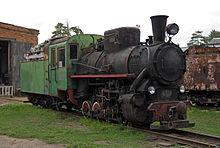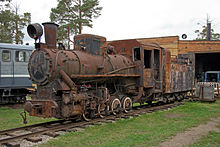Pereslavl Narrow Gauge Railway Museum
 Steam locomotive Ft4-028 (Фт4-028) |
|
| Data | |
|---|---|
| place |
Pereslavl-Zalessky |
| Website | |
The narrow-gauge railway museum Pereslawl ( Russian Переславский железнодорожный музей , transkr. Pereslawski schelesnodoroschny musei , transl. Pereslavskij železnodorožnyj muzej ) is a private technical museum in Pereslavl-Zalessky in Yaroslavl Oblast in Russia , are collected in the rolling of narrow-gauge railways and similar machines.


history
In 1989 Vadim Vadimowitsch Mironov met the owner of the Yaroslavl cooperative "Decor" Anatoly Fyodorowitsch Gusew. They decided to buy a narrow-gauge railway and turn it into a museum. Mironov and his wife Kira financed the travel necessary for the research.
The museum was founded in 1991 after the “Decor” cooperative was dissolved. Originally it existed as a private collection with limited access for visitors, but with the possibility of arranging tailor-made trips in museum trains on the Pereslavl museum narrow-gauge railway .
The museum has been open to visitors for free since 1998, and an entrance fee has been charged since 2006. The number of visitors occasionally reached up to 800 per day.
In the years 2002-2004, the museum repeatedly organized locomotive festivals for a wide variety of visitors. In the years 2002–2003 the museum operated a regular passenger service from the Kupanskoe settlement to Pereslavl. Since 2006 the museum has only two kilometers of track.
In 2008 the museum received 480,000,000 rubles from the Potanin Charity Foundation (“ Меняющийся музей в меняющемся мире ” (German: “A changing museum in a changing world”)). With these funds, the access road was repaired, street signs and traffic signs were installed and appropriate posters were hung up. There is a parking lot at the entrance to the village.
At the beginning of 2009, the museum was the only railway museum in Russia that specialized exclusively in narrow-gauge locomotives and cars. The Sharja Open-Air Forest Railway Museum and the Yekaterinburg Narrow -Gauge Railway Museum were only opened five to seven years later.
In 2010, 200 meters of track were restored, with the superstructure and substructure being completely replaced. In 2011 the restoration work continued and to this day the entire route is about one kilometer long. It is planned to continue the restoration work on the track construction and the exhibits and to erect new protective roofs over the exhibits.
Exhibits
The museum shows vehicles from field railways , peat railways, forest railways and other narrow-gauge railways. Many of the exhibits are the only examples of their kind that have been preserved and are listed as technical monuments. Some locomotives, machines and mechanisms will be made functional again. The exhibits often need to be repaired. According to the director of the museum, the collection should no longer be expanded from 2012 in order to be able to devote more attention to the restoration.
Steam locomotives and their fragments
Four steam locomotives built between 1928 and 1955 were refurbished in the museum's collection. Further rail vehicles are ready for restoration and fragments of important steam locomotives are on display:
- Steam locomotive 157-469 - Kolomna locomotive factory in 1928, under construction
- Steam locomotive F4-028 - Tampella ( Tampere / Finland) 1945, operational, the only one preserved worldwide
- Steam locomotive Gr-269 - Lokomotivbau Karl Marx Babelsberg / Germany, delivered to the still unfinished children's railway Grozny in the 1950s , operational
- Steam locomotive Кп 4-469 - Dzerzhinsky works in Chrzanów / Poland 1955, operational
- Steam locomotive Kn 4-300 - Dzerzhinsky works in Chrzanów / Poland 1955, not operational
- Steam locomotive VP4-2120 - Votkinsk machine building 1958, with three-axle tender VP4-1862
- Boiler of the locomotive type 63 (wheel arrangement D) - Lokomotivfabrik Kolomna, probably 1918
- Fragment of the E-series tank locomotive - Kolomna locomotive factory, built in 1921
- Fragment of a tank locomotive with the C wheel arrangement with a 900 mm gauge - Krauss / Germany, 1880s
- Tender of locomotive 159, 1930s
Diesel locomotives
- Four-axle locomotive MD54-4-1547 - Istiinsky Maschinenbauwerk, 1963 (operational)
- Shunting locomotive MD54-2 - Istiinsky-Maschinenbauwerk (operational again since 2001)
- Diesel locomotive TU4-1984 - Maschinenfabrik Kambarka 1969, operational, was used for regular passenger traffic
- Four-axle locomotive with generator ESU2a-511 Mechanical plant by Guba, operational, was used for scheduled passenger traffic
- Four-axle locomotive with ESU3-2 generator (was temporarily stored in the museum from 2011 to 2017)
Self-driving vehicles
- Passenger trolley № 51 - Shatura railway workshops, 1930s.
- Precinct Autodraisine UA No. 4727 - machine factory Kaluga , built in 1939.
- Passenger autodraisine PD1 - Maschinenfabrik Demichowo , 1950s.
- Fire Brigade PMD-3-259 - Demichowo, 1960s.
- Last-Draisine GMD4 - Demichowo, 1960s.
- Draisine based on the ZIM (GAZ-12) car.
- TDU5 motorcycle - Kaluga machine factory, 1950s.
- Handcart - Vyksa railway workshops, early 20th century
dare
- Passenger car - Malzowski-Werk and Waggonbau Görlitz (Germany) etc. built 1898–1935
- Open car of the "Azneft", Baku oil fields built in 1928 (reconstructed from the ground up in 2010 and made operational)
- Freight cars from various manufacturers from the 1890s and 1960s
- Tank cars built between 1900s and 1920s
- Bjorke system snow plows, built between 1928–1953
Railway equipment
- Electrically operated devices of the Ingenieur Treger System from 1924
- Fire service equipment from the 1890s to the 1950s
- The bell of Trufanovo station on the former UZD Tula-Likhvin railway line.
Movie and TV
Museum exhibits are often used for film and television shootings. On the premises of the museum, some episodes of the film by Peter Todorovsky Anchor, Still An Anchor (1992), many episodes of the television series Saboteur by Andrei Malyukov (2004), the television series Saboteur. End of the war by Igor Zaitsev (2007), as well as The Heart of the Enemy by Alexander Vysokovsky.
Individual evidence
- ↑ Е. Серьгина: Железнодорожная бухгалтерия In: BusinessWeek Россия. April 14, 2008 (Russian).
- ↑ А. Можаев: ( Page no longer available , search in web archives: Пролетарий у гнезда «Кукушки» ) Gudok.ru, August 4, 2006.
- ↑ А. Корсаков: Купанское транспортное управление (история великана). . In: «Младший брат. Энциклопедия отечественных узкоколеек ». . Archived from the original on January 31, 2013.
- ↑ a b А. Тулякова: Музейная касса ( Memento from September 27, 2007 in the Internet Archive ) In: Бизнес-журнал. No. 23, 2006.
- ↑ Фонд Потанина: победители конкурса 2008 года (winner 2008).
- ↑ ( Page no longer available , search in web archives: Сельский автобус 1940-х годов )
- ↑ ( Page no longer available , search in web archives: Музеи, меняющие мир ) Interros. No. 3, 2008.
- ↑ Переславский железнодорожный музей: Каталог. - Талицы, 2006.




